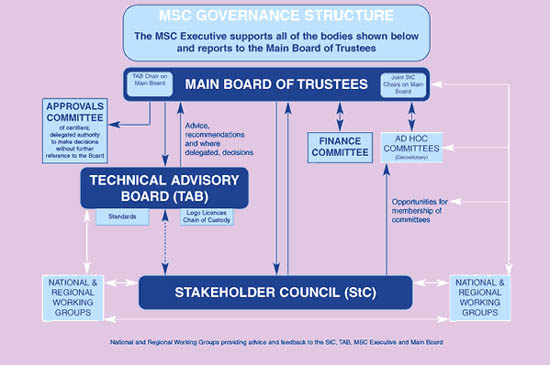The Governance Structure of the Marine Stewardship Council (MSC)
The promoters of the MSC were a non-governmental organization (WWF) and a private company (Unilever). They set up MSC as an independent non-profit organization. The Chief Executive of MSC reports to the Main Board of Trustees (MBT). A first task of MSC was to develop the MSC certification standard (MSC Principles and Criteria) which encapsulates the objectives of the scheme. MSC also serves as an accreditation body of certification agencies which are private firms.
The governance structure of MSC is shown in the below graph. This and the following description of the functions of the different boards is taken from the MSC web site (www.msc.org).
The Technical Advisory Board (TAB) of eleven members advises the MBT on all relevant matters including the setting and review of the MSC Standard. The MBT is strongly guided by the TAB’s advice and it will set out its reasons when reaching a different conclusion to the TAB. The TAB is able to call in ad hoc skills and/or form sub-committees to focus specific expertise on specific topics or functions. The TAB, before making final recommendations to the MBT, will where appropriate first circulate their proposed recommendations amongst Stakeholder Council members and other relevant interest groups. The TAB considers any feedback arising and advises the MBT accordingly when submitting a final recommendation. The MBT is responsible for appointing the TAB whilst the TAB is responsible for appointing its own Chair.
The Stakeholder Council (StC) is a well-defined and balanced stakeholder body of 30-50 members fulfilling specific roles and acting as a point of reference, participation, liaison and representation. Half the members have been appointed by the MBT in consultation with the MSC Executive. The remaining half have been appointed by the current members. Each StC constituency is responsible for its own nominations and appointments. There are currently eight defined constituencies, four in the public and four in the private arena, each represented with five seats. The public interest categories include Scientific, Academic & Resource Management; General Conservation NGOs & Interests; Marine Conservation NGOs & Specialist Interests; General Interests & Organisations. The commercial and socio-economic interest categories include Catch Sector Interests; Supply Chain & Processing Interests; Retail, Catering & Distribution Interests; and Developing Nation & Fishing Community Interests. The StC meets annually. Annual StC meetings include an open convention event for all interested parties at which reports from, in person, the Chairman of the MBT and the MSC Chief Executive will be presented and discussed. The StC has two joint chairs who have seats on the MBT and thereby be involved, on behalf of StC members, in all MBT matters, decisions and appointments.

Source: www.msc.org
Governance Structure of the European Union EcoLabel Scheme for Industrial Products
The promoter of the EU Ecolabel is the European Union. The Regulation (EC) No 1980/2000 of the European Parliament and of the Council of 17 July 2000 on a revised Community Ecolabel Award Scheme provides the legal basis for the scheme, an overview of which is provided below. This voluntary scheme excludes all food, drink and medicinal items.
Institutionally, the central body of the EU Ecolabel is the European Union Eco-labelling Board (EUEB) which consists of the Competent Bodies and the Consultation Forum. The primary task of the EUEB, with the specific mandate given to it by the European Commission for each product group, is to contribute to the setting and review of ecolabelling criteria as well as the assessment and verification requirements (Article 13).
The Commission is required to ensure that in the conduct of its activities, the EUEB observes, in respect of each product group, a balanced participation of all relevant interested parties concerned with that product group such as industry and service providers, trade unions, traders, retailers, importers, environmental protection groups and consumer organizations. These parties meet in a Consultation Forum (Article 15).
A key role in the EU Ecolabel scheme is performed by a Competent Body (CB) or Competent Bodies which each EU Member State is required to designate. Member States need to ensure that (a) the composition of the CBs is such as to guarantee their independence and neutrality, (b) the rules of procedure of the CBs ensure, at national level, the active involvement of all interested parties and an appropriate level of transparency, and (c) the CBs apply correctly the provisions of Regulation (EC) No 1980/2000.
As indicated in the flow-chart below, the final adoption of ecolabelling criteria is made by a Regulatory Committee which is composed of representatives of EU Member States. Verification and compliance control functions are performed by the competent bodies in each Member State.
An overview of the EU Ecolabel Scheme
